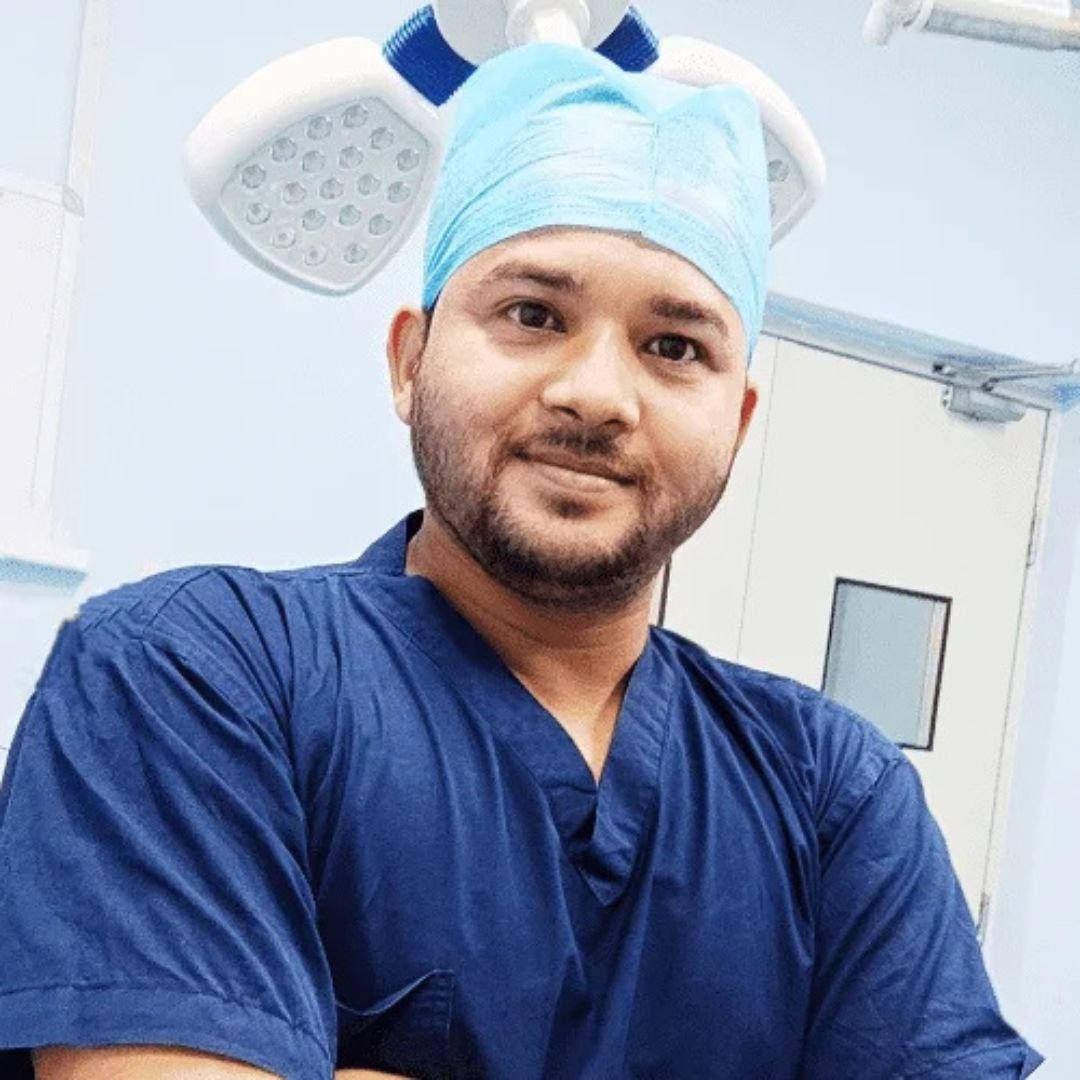Breast Augmentation Surgery
Breast augmentation surgery is a transformative procedure designed to enhance the size, shape, and symmetry of the breasts. Whether you’re looking to restore volume lost due to pregnancy, weight loss, or aging, or simply desire a more proportionate figure, this procedure can help you achieve your aesthetic goals. At Bharatkare, we specialize in providing personalized care and advanced surgical techniques to ensure natural-looking results. Our team of experienced breast augmentation surgeons is dedicated to helping you feel confident and comfortable in your own skin.
Book Appointments With Our Expert Doctors Near You
- Get consultation for 50+ diseases across India
- In-person and online consultation with experienced doctors
- Extensive medical assistance throughout your treatment


Dr Ashish Sachdeva
MBBS, MS - General Surgery, General Surgeon, Bariatric Surgeon, Laparoscopic Surgeon
4.9/5
20 Years Experience
Vadodara, India

Dr. Tanmay Jain
General Surgeon, Laparoscopic Surgeon and Proctologist
4.9/5
12 Years Experience
Jaipur, India

Dr. Vikram Vasuniya
MBBS, MS (General Surgery) General Laparoscopic & Laser Surgeon, Laser Proctologist
4.9/5
14 Years Experience
Bhopal, India

Dr. Sujeet Kumar Bharti
MBBS, MS (General Surgery) General Laparoscopic & Laser Surgeon, Laser Proctologist
4.9/5
22 Years Experience
Patna, India
What is Breast Augmentation Surgery?
Breast augmentation surgery, also known as augmentation mammoplasty, is a cosmetic procedure that involves the placement of implants or fat transfer to increase the size and improve the shape of the breasts. This surgery is ideal for women who feel their breasts are too small, uneven, or have lost volume over time.
The procedure is highly customizable, allowing patients to choose the type, size, and shape of implants that best suit their body type and desired outcome. Silicone and saline implants are the most commonly used options, each offering unique benefits. Silicone implants are known for their natural feel, while saline implants are adjustable and provide a firmer appearance.
During the consultation, your breast augmentation doctor will evaluate your anatomy, discuss your goals, and recommend the best approach to achieve your desired results. The surgery is performed under general anesthesia and typically takes 1-2 hours, depending on the complexity of the case.
Disease name
Breast Augmentation
Surgery name
Augmentation Mammoplasty
Duration
1-2 hours
Treated by
Plastic or cosmetic surgeon
Breast Augmentation Before and After: What to Expect
One of the most exciting aspects of breast augmentation surgery is seeing the dramatic transformation in your appearance. Breast augmentation before and after photos can give you a realistic idea of what to expect from the procedure. These images showcase the skill of the surgeon and the potential results you can achieve.
Before the surgery, your breasts may appear asymmetrical, sagging, or lacking volume. After the procedure, you’ll notice a fuller, more balanced contour that enhances your overall silhouette. The results are long-lasting, though they may be affected by factors such as weight fluctuations, aging, and pregnancy.
It’s important to have realistic expectations and understand that while breast augmentation surgery can significantly improve your appearance, it may not completely resolve underlying issues such as severe sagging. In such cases, a breast lift may be recommended in combination with augmentation.
Diet After Breast Augmentation Surgery
A healthy diet after breast augmentation surgery plays a crucial role in your recovery and overall results. Proper nutrition helps your body heal, reduces the risk of complications, and ensures you feel your best during the recovery process.
In the initial days following surgery, focus on eating light, easily digestible foods such as soups, broths, and steamed vegetables. Avoid heavy, greasy, or spicy meals that could cause discomfort or nausea. Staying hydrated is equally important, so drink plenty of water throughout the day.
As your body heals, incorporate nutrient-rich foods that promote tissue repair and reduce inflammation. These include:
- Protein-rich foods: Lean meats, fish, eggs, and legumes help rebuild tissues and support muscle recovery.
- Vitamin C: Found in citrus fruits, strawberries, and bell peppers, vitamin C boosts collagen production and strengthens the immune system.
- Omega-3 fatty acids: Salmon, walnuts, and flaxseeds reduce inflammation and support overall health.
- Fiber: Whole grains, fruits, and vegetables prevent constipation, which can be a side effect of pain medications.
Avoid alcohol and caffeine during the initial recovery period, as they can dehydrate your body and interfere with healing. If you have any dietary restrictions or concerns, consult your breast augmentation surgeon for personalized recommendations.
Exercises After Breast Augmentation Surgery
While rest is essential in the early stages of recovery, gentle exercises after breast augmentation surgery can help you regain strength and mobility. However, it’s crucial to follow your surgeon’s guidelines to avoid straining your chest muscles or compromising the results.
During the first week, focus on light activities such as short walks to improve circulation and prevent blood clots. Avoid lifting heavy objects or engaging in strenuous activities that could put pressure on your chest.
After 2-3 weeks, you can gradually reintroduce low-impact exercises such as yoga, stretching, and light cardio. Avoid upper body workouts or activities that involve repetitive arm movements until you receive clearance from your breast augmentation doctor.
By 6-8 weeks, most patients can resume their regular exercise routine, including strength training and high-intensity workouts. Listen to your body and avoid pushing yourself too hard, as overexertion can delay healing and affect the final results.
Choosing the Right Breast Augmentation Surgeon
The success of your breast augmentation surgery largely depends on the skill and experience of your surgeon. When choosing a breast augmentation surgeon, it’s important to do thorough research and select a board-certified professional with a proven track record of successful outcomes.
At Bharatkare, we pride ourselves on having some of the best breast augmentation doctors in India. Our surgeons are highly trained in the latest techniques and use state-of-the-art technology to ensure safe and effective results. During your consultation, your surgeon will take the time to understand your goals, answer your questions, and create a customized treatment plan tailored to your needs.
When evaluating potential surgeons, consider the following factors:
- Credentials: Ensure the surgeon is board-certified and has specialized training in cosmetic surgery.
- Experience: Look for a surgeon who has performed a high volume of breast augmentation surgeries and has a portfolio of before-and-after photos.
- Patient reviews: Read testimonials from previous patients to gauge their satisfaction and overall experience.
- Communication: Choose a surgeon who makes you feel comfortable, listens to your concerns, and provides clear, honest answers.
How to Prepare for Breast Augmentation Surgery
Preparing for breast augmentation surgery is a crucial step to ensure a smooth procedure and recovery. Your breast augmentation surgeon will provide detailed instructions tailored to your specific needs, but here are some general guidelines to help you get ready:
- Consultation and Planning:
During your initial consultation, discuss your goals, medical history, and any concerns with your surgeon. They will evaluate your anatomy, recommend the type and size of implants, and explain the procedure in detail. - Medical Evaluation:
You may need to undergo blood tests, a mammogram, or other diagnostic tests to ensure you’re in good health for surgery. Inform your surgeon about any medications, supplements, or allergies you have. - Lifestyle Adjustments:
- Stop smoking at least 4-6 weeks before surgery, as smoking can impair healing and increase the risk of complications.
- Avoid alcohol and certain medications (e.g., aspirin, ibuprofen) that can thin the blood and increase bleeding.
- Maintain a healthy diet and exercise routine to optimize your overall health.
- Arrange for Support:
You’ll need someone to drive you home after the surgery and assist you during the first few days of recovery. Plan to take at least 1-2 weeks off work or other responsibilities to focus on healing. - Prepare Your Recovery Space:
Set up a comfortable area at home with essentials such as loose-fitting clothing, pillows for elevation, and easy-to-prepare meals.
By following these steps, you can minimize risks and ensure a positive experience with your breast augmentation surgery.
What Happens During Breast Augmentation Surgery?
Understanding the process of breast augmentation surgery can help alleviate any anxiety and prepare you for the big day. Here’s a step-by-step overview of what to expect:
- Anesthesia:
The procedure begins with the administration of general anesthesia to ensure you’re comfortable and pain-free throughout the surgery. - Incision Placement:
Your surgeon will make incisions in discreet locations to minimize visible scarring. Common incision sites include:- Inframammary fold: Beneath the breast crease.
- Periareolar: Around the edge of the areola.
- Transaxillary: In the armpit area.
- Implant Placement:
The implants are carefully inserted either:- Subglandular: Above the chest muscle.
- Submuscular: Beneath the chest muscle.
Your surgeon will determine the best placement based on your anatomy and desired outcome.
- Closing the Incisions:
The incisions are closed with sutures, and surgical tape or skin adhesive is applied to support the healing process. - Recovery Room:
After the surgery, you’ll be moved to a recovery area where your vital signs will be monitored as you wake up from anesthesia.
The entire procedure typically takes 1-2 hours, and most patients can return home the same day.
Recovery Tips After Breast Augmentation Surgery
Recovery is a critical phase of your breast augmentation surgery journey. Following your surgeon’s post-operative instructions will help you heal faster and achieve the best possible results. Here are some essential recovery tips:
- Rest and Elevation:
- Take plenty of rest during the first week and avoid strenuous activities.
- Sleep on your back with your upper body slightly elevated to reduce swelling.
- Pain Management:
- Take prescribed pain medications as directed to manage discomfort.
- Use cold compresses to alleviate swelling and soreness.
- Wound Care:
- Keep the incision sites clean and dry to prevent infection.
- Follow your surgeon’s instructions for changing dressings and caring for drains, if used.
- Compression Garments:
Wear a surgical bra or compression garment to support the breasts, reduce swelling, and promote proper healing. - Activity Restrictions:
- Avoid lifting heavy objects or raising your arms above your head for at least 4-6 weeks.
- Gradually reintroduce light activities as recommended by your surgeon.
- Follow-Up Appointments:
Attend all scheduled follow-up visits to monitor your progress and address any concerns.
By adhering to these tips, you can ensure a smooth recovery and enjoy your new look with confidence.
When is Breast Augmentation Surgery Required?
Breast augmentation surgery is not just a cosmetic procedure; it can also address various physical and emotional concerns. Here are some common reasons why women choose this surgery:
- Enhancing Breast Size:
Women who feel their breasts are too small or disproportionate to their body frame often opt for breast augmentation surgery to achieve a more balanced appearance. - Restoring Volume:
Pregnancy, breastfeeding, weight loss, and aging can cause the breasts to lose volume and sag. Implants can restore fullness and improve shape. - Correcting Asymmetry:
Many women have naturally uneven breasts. Breast augmentation surgery can create symmetry and boost self-confidence. - Reconstructive Purposes:
Women who have undergone mastectomy due to breast cancer may choose breast augmentation as part of their reconstructive journey. - Boosting Self-Esteem:
For some women, enhancing their breast size can have a profound impact on their self-image and overall confidence.
If you’re considering breast augmentation surgery, consult with a qualified breast augmentation doctor to determine if it’s the right choice for you.
Benefits of Breast Augmentation Surgery
Breast augmentation surgery offers numerous physical and psychological benefits, making it one of the most popular cosmetic procedures worldwide. Here are some key advantages:
- Enhanced Appearance:
The procedure provides a fuller, more proportionate breast contour that complements your body shape. - Improved Confidence:
Many women experience a significant boost in self-esteem and feel more comfortable in their own skin. - Long-Lasting Results:
With proper care, the results of breast augmentation surgery can last for many years. - Customizable Options:
Patients can choose the size, shape, and type of implants to achieve their desired look. - Minimal Scarring:
Advanced surgical techniques ensure that incisions are discreet and scars fade over time. - Quick Recovery:
Most patients can resume normal activities within a few weeks, with minimal downtime.
Breast Augmentation Cost in India
The breast augmentation cost in India varies depending on several factors, including the surgeon’s experience, the type of implants used, and the facility’s location. While we don’t provide specific pricing details, we encourage you to contact Bharatkare for a personalized quote.
Here’s a breakdown of factors that influence the cost:
Factor | Description |
Surgeon’s Expertise | Highly experienced surgeons may charge more for their skills and reputation. |
Type of Implants | Silicone implants are typically more expensive than saline implants. |
Facility Fees | Premium hospitals or clinics may have higher fees for advanced amenities. |
Geographic Location | Costs may vary depending on the city or region where the surgery is performed. |
Additional Procedures | Combining breast augmentation with a lift or other procedures can increase costs. |
Investing in a skilled breast augmentation surgeon and a reputable facility ensures safe and satisfying results.
Risks and Complications of Breast Augmentation Surgery
While breast augmentation surgery is generally safe, like any surgical procedure, it carries certain risks. Being aware of these potential complications can help you make an informed decision and take necessary precautions.
- Infection:
Although rare, infections can occur after surgery. Symptoms include redness, swelling, and fever. Prompt treatment with antibiotics is essential to prevent further complications. - Capsular Contracture:
This occurs when scar tissue forms around the implant, causing the breast to feel hard or look distorted. Additional surgery may be required to correct this issue. - Implant Rupture or Leakage:
Implants can rupture or leak over time, requiring replacement. Regular follow-ups with your breast augmentation surgeon can help detect this early. - Changes in Sensation:
Some patients experience temporary or permanent changes in nipple or breast sensation. This usually resolves within a few months but can be permanent in rare cases. - Asymmetry:
While surgeons strive for symmetry, slight differences in breast size or shape may occur. Revision surgery can address this if necessary. - Anesthesia Risks:
General anesthesia carries its own risks, such as allergic reactions or respiratory issues. Your surgeon will evaluate your medical history to minimize these risks. - Scarring:
While incisions are made in discreet locations, some scarring is inevitable. Proper wound care can help scars fade over time.
By choosing an experienced breast augmentation doctor and following pre- and post-operative instructions, you can significantly reduce the likelihood of complications.
Alternatives to Breast Augmentation Surgery
If you’re unsure about breast augmentation surgery, there are non-surgical alternatives that can enhance your breast appearance. While these options may not provide the same dramatic results as surgery, they can be a good starting point for those seeking subtle changes.
- Fat Transfer Breast Augmentation:
This procedure involves harvesting fat from another part of your body (e.g., abdomen or thighs) and injecting it into the breasts. It’s ideal for women who want a modest increase in size without implants. - Breast Lift (Mastopexy):
A breast lift addresses sagging by removing excess skin and tightening the surrounding tissue. It doesn’t increase breast size but can improve shape and firmness. - Non-Surgical Enhancements:
- Vacuum Bras: These devices use suction to temporarily enlarge the breasts.
- Topical Creams and Serums: Some products claim to enhance breast size, though results are often minimal.
- Exercises: Strengthening the chest muscles can improve the appearance of the breasts but won’t increase their size.
- Push-Up Bras and Inserts:
These provide an instant boost in size and shape without any medical intervention.
Consult your breast augmentation surgeon to explore these alternatives and determine the best option for your needs.
Long-Term Care and Maintenance After Breast Augmentation Surgery
To ensure the longevity of your results and maintain the health of your breasts, it’s important to follow a long-term care plan after breast augmentation surgery.
- Regular Check-Ups:
Schedule annual visits with your breast augmentation doctor to monitor the condition of your implants and overall breast health. - Self-Examinations:
Perform monthly breast self-exams to check for any changes, such as lumps, pain, or asymmetry. Report any concerns to your surgeon immediately. - Mammograms:
Inform your radiologist about your implants before undergoing a mammogram. Special techniques may be required to get clear images. - Healthy Lifestyle:
Maintain a balanced diet, exercise regularly, and avoid smoking to support your overall health and the longevity of your results. - Implant Replacement:
While implants are designed to last for many years, they may need to be replaced after 10-15 years. Regular monitoring can help you decide when replacement is necessary.
By prioritizing long-term care, you can enjoy the benefits of breast augmentation surgery for years to come.
Choosing the Right Implant Size and Type
Selecting the right implant size and type is one of the most important decisions in your breast augmentation surgery journey. Here’s a detailed guide to help you make an informed choice:
- Implant Size:
- Consider your body frame, lifestyle, and aesthetic goals when choosing the size.
- Your breast augmentation surgeon may use sizers during the consultation to help you visualize the results.
- Implant Type:
- Silicone Implants: Known for their natural feel and durability, silicone implants are a popular choice.
- Saline Implants: These are filled with sterile salt water and offer a firmer feel. They can be adjusted during surgery for precise sizing.
- Gummy Bear Implants: A type of silicone implant with a cohesive gel that retains its shape even if the shell ruptures.
- Implant Shape:
- Round Implants: Provide a fuller appearance and are ideal for adding volume.
- Teardrop Implants: Mimic the natural shape of the breast, with more volume at the bottom.
- Implant Profile:
The profile refers to how far the implant projects from the chest wall. Options include low, moderate, high, and ultra-high profiles.
Your breast augmentation doctor will guide you through the selection process, ensuring your choice aligns with your goals and anatomy.
Recovery Timeline After Breast Augmentation Surgery
Understanding the recovery timeline after breast augmentation surgery can help you plan your post-operative care and set realistic expectations. Here’s a detailed breakdown of what to expect during each phase of recovery:
Recovery Phase | Timeline | What to Expect |
Immediate Post-Op | 1-2 Days | – Grogginess and discomfort due to anesthesia. – Mild to moderate pain and swelling. – Limited mobility; assistance required for daily tasks. |
First Week | 3-7 Days | – Pain and swelling begin to subside. – Prescribed medications help manage discomfort. – Light activities like short walks are encouraged. |
Weeks 2-3 | 2-3 Weeks | – Most patients return to work and light daily activities. – Swelling continues to decrease. – Avoid heavy lifting or strenuous exercises. |
Weeks 4-6 | 4-6 Weeks | – Gradual return to moderate exercises (e.g., light cardio, stretching). – Incision sites heal, and scars begin to fade. – Follow-up appointments to monitor progress. |
Months 2-3 | 2-3 Months | – Full recovery for most patients. – Swelling resolves, and final results become visible. – Resume all normal activities, including intense workouts. |
Long-Term | 6+ Months | – Implants settle into their final position. – Scars continue to fade over time. – Annual check-ups to ensure implant health. |
By following your breast augmentation surgeon’s guidelines and listening to your body, you can ensure a smooth and successful recovery.
FAQ
You Can Find All Answers Here
There is no specific age requirement, but most surgeons recommend waiting until the breasts are fully developed, typically after 18 years of age.
The surgery usually takes 1-2 hours, depending on the complexity of the case.
Scars are inevitable, but they are strategically placed in discreet locations and fade over time with proper care.
Yes, many patients choose to combine breast augmentation surgery with a breast lift, tummy tuck, or liposuction for comprehensive results.
Most patients can return to work within 1-2 weeks, depending on the nature of their job.
When performed by a qualified breast augmentation surgeon, the procedure is generally safe. However, like any surgery, it carries some risks.
In most cases, yes. The ability to breastfeed depends on the incision placement and surgical technique.
Your surgeon will help you choose the size based on your body frame, lifestyle, and aesthetic goals.
Implants are designed to last for many years, but they may need to be replaced after 10-15 years.
Yes, you’ll need to wear a surgical bra or compression garment to support healing and maintain the position of the implants.
Quick Links
Popular Surgeries
Find Us
© Copyright BharatKare 2025. All Right Reserved.



